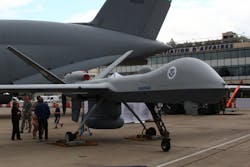Industry, FAA, and homeland security officials test GA-ASI and BAE Systems avionics on RPA, demonstrate safe integration of drones in national airspace
SAN DIEGO, 26 Oct. 2012. Officials at General Atomics Aeronautical Systems Inc. (GA‑ASI), the U.S. Department of Homeland Security, Customs and Border Protection, and the FAA tested an Automatic Dependent Surveillance-Broadcast (ADS-B)-based surveillance system on a Predator/Gray Eagle-series aircraft, in an effort to demonstrate and enhance remotely piloted aircraft (RPA) flight safety.
“We are working closely with the FAA, other governmental agencies, and industry partners to advance the safety of RPA,” explains Frank W. Pace, president, Aircraft Systems Group, GA-ASI. “We believe ADS-B will play a key role in a future sense-and-avoid system and will support the FAA’s ‘Next Gen’ initiative, so this is a step in the right direction.”
The test involved GA-ASI’s Guardian RPA, a Predator B unmanned aerial vehicle (UAV) configured for maritime operations, and a prototype of BAE Systems’ AN/DPX-7 Reduced Size Transponder, a military-grade Identification Friend or Foe (IFF) device. The ADS-B-capable transponder interoperates with military and civilian Air Traffic Control (ATC) surveillance systems.
During the test, Guardian’s ADS-B IN-capable transponder detected other ADS-B-equipped aircraft in the vicinity, displaying the aircraft on the ground control station (GCS) display. Guardian’s ADS-B OUT transponder simultaneously notified other aircraft and ATC of its location and velocity.
The goal was to demonstrate that Predator/Gray Eagle-series aircraft can fly cooperatively and safely in the National Airspace System (NAS), enabling ATC to know their location and flight profiles precisely, describes a spokesperson.
GA-ASI is a manufacturer of remotely piloted aircraft (RPA), tactical reconnaissance radars, and electro-optic surveillance systems.
ADS-B is the GPS-based surveillance system that is the cornerstone of the FAA’s NextGen Air Traffic Management (ATM) system, which aims to convert America’s ATC system from a ground-based system to a satellite-based system, resulting in simplified air traffic logistics and enhanced aircraft safety margins. The FAA has mandated that all aircraft flying above 10,000 feet or around major U.S. airports must be ADS-B equipped by 2020.
Follow Avionics Intelligence news updates on Twitter (@Avionics_Intel), LinkedIn, and Google+.
Image courtesy Shutterstock.
